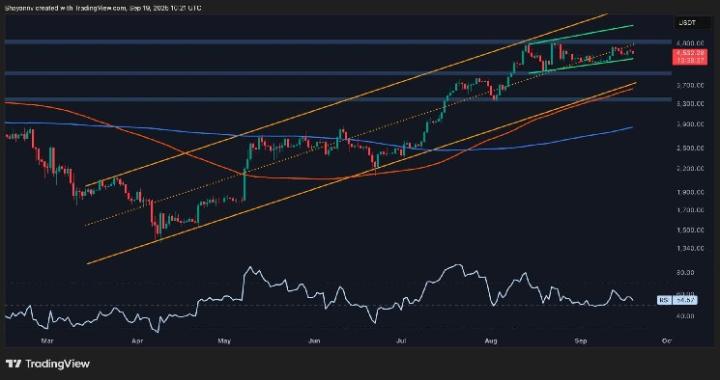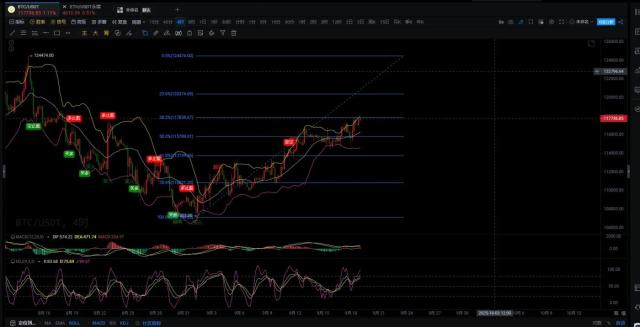summary
Core Problem Solved: Institutions need stable returns, but funding rates fluctuate drastically. Boros converts volatility into fixed returns. Market Opportunity: With a first-mover advantage in the DeFi derivatives field, it has become an indispensable infrastructure expansion suite for strategies like Ethena Delta Neutral. Vision: From the crypto funding rate expansion suite to traditional finance (bonds, stocks), leading the on-chain derivatives market.
The untapped potential behind DeFi’s success
While the crypto market has spawned many narratives, DeFi and derivatives trading have demonstrated the strongest product-market fit.
DeFi’s initial growth came from lending protocols like Aave and Compound, decentralized exchanges like Uniswap, and yield farming mechanisms. These rebuilt core financial primitives in a permissionless environment, opening up access to services previously limited to institutions.
As these markets matured, DeFi began expanding its suite into derivatives, following a similar trajectory to traditional finance. In traditional markets, derivatives have achieved scale and liquidity far exceeding spot trading. A similar shift is occurring in crypto, with permissionless derivatives emerging as the next growth driver.
Pendle: Financial Engineering in DeFi

Source: Pendle
Pendle launched in 2021 and positions itself as a leading project bringing structured derivatives to DeFi.

The key takeaway was to separate the principal and yield of interest-bearing tokens. The timing was effective: yield staking was becoming mainstream, and by 2023, the narrative of staking and future airdrops was gaining prominence, attracting even more attention to Pendle. Today, many new projects are integrating Pendle as a base layer for yield-related strategies.
Its core mechanism is deceptively simple, but it effectively creates two distinct asset classes: a discounted claim on future value (PT) and a product with pure exposure to interest rate fluctuations (YT).
The implications are significant. With Pendle, interest-bearing assets like stETH or rETH are no longer limited to being collateral replacements; they can now serve as building blocks for more complex strategies.
Investors seeking to capitalize on rising yields can buy YT, acquiring a leveraged position that can exceed six times, depending on market conditions. Conversely, investors seeking a fixed return can buy PT, often locking in a double-digit discount to future value.
More importantly, Pendle's design improves capital efficiency across DeFi. Strategies that once required complex hedging or derivatives expertise are now simplified through its profit-splitting mechanism. Investors can now access, trade, and customize profit positions on-chain.
By doing so, Pendle not only introduces a new concept of yield, but also lays the foundation for financial engineering in DeFi, providing users with institutional-grade tools in a permissionless format.
Boros: Enabling Delta Neutral Returns
As the crypto market expands, institutions are deploying larger capital bases and adopting more sophisticated trading strategies to generate returns. Their priority is stable returns, which is often achieved through delta-neutral positions to minimize price risk.

Ethena demonstrates this by holding spot ETH while simultaneously short an equal amount in the futures market. Gains on one offset losses on the other, keeping the portfolio value stable regardless of price direction (see chart).
In a bull market, longs pay funding rates to shorts, allowing Ethena to earn income. In a bear market, the opposite happens, and Ethena must pay funding rates.
The challenge is that money flows are inherently volatile—sometimes generating income, other times requiring payments. This volatility harms protocols like Ethena, which rely on a delta-neutral strategy to support its stablecoin, USDe.

Source: Pendle
Boros addresses this gap by transforming volatile funding fee streams into fixed, predictable returns. By doing so, it provides the stability institutions need to expand their capital deployment in the crypto markets.
Boros Mechanism: Stabilizing Funding Rates
Boros introduces Yield Units (YUs), a derivative instrument that decouples funding rate volatility from underlying asset prices. YUs simultaneously allow for two things: directional betting on funding rates and converting volatile funding flows into predictable income streams. The following section explains how this works.
Yield Unit (YU): Structure and Purpose
Let’s say an investor wants a fixed annualized return of 8% over three months, regardless of whether the Bitcoin funding rate is positive or negative. Conversely, another investor might prefer direct exposure to funding rate fluctuations, willing to pay a fixed return in exchange.
YU connects these two parties by isolating and trading only the volatility of the funding rate (independent of the underlying asset price changes).

Source: Boros, Tiger Research
For example, the product "1 YU-ETHUSDT-Binance" represents the perpetual contract funding rate for one ETH notional position on the Binance exchange, until expiration. Purchasing this product allows investors to profit or lose based on changes in the funding rate associated with that position without having to hold ETH itself. In this way, YU transforms the funding rate of a specific exchange-asset pair into a standalone, tradable instrument.
Implied APR: Market expectations as price signals

Source: Boros, Tiger Research
A core concept in YU trading is the implied annualized rate of return. This represents the market's expectation of the average funding rate until maturity, as reflected in the current price of YU.
Just as the $80,000 Bitcoin price reflects the market’s valuation of the asset, YU-BTCUSDT’s 8% implied annualized yield suggests that participants expect Bitcoin funding rates to average 8% annually over the relevant period.
In short, the implied annualized rate of return functions much like the market price in the futures market: it reflects the market's consensus view at the moment.
- Long/Short Top Positions: Implied and Actual Returns
A YU position is similar to a futures trade, but the motivations for long and short positions are different.
- Bitcoin Futures Long: Mark Price $50,000 → Target Price $60,000 = $10,000 Profit
YU Long: Implied Annualized Yield 8% → Underlying Annualized Yield 10% = 2% Profit (Long pays the Implied Annualized Yield and receives the Underlying Annualized Yield)
The YU long top position reflects the belief that "the actual funding rate will be higher than the market's current 8% expectation, say 10%." In this case, the long position pays funding based on the implied annualized rate of return (8%) and receives funding based on the underlying annualized rate of return (10%). This is equivalent to saying, "Bitcoin futures are currently at $50,000, but I expect it to rise to $60,000," and long.
- Bitcoin Futures Short: Mark Price $50,000 → Target Price $40,000 = $10,000 Profit
YU Short: Implied Annualized Yield 20% → Underlying Annualized Yield 15% = 5% Profit (Short receives Implied Annualized Yield and pays Underlying Annualized Yield)
The YU short top position reflects the belief that "the actual funding rate will be lower than the market's current 20% expectation, say 15%." Here, the short seller receives funding based on the implied annualized rate of return (20%) and pays funding based on the underlying annualized rate of return (15%). This is similar to saying, "Bitcoin futures are currently at $50,000, but I expect them to fall to $40,000," and then short.
Simply put, Bitcoin futures represent a bet on current price vs. future price, while YU represents a bet on current market expectations (implied annualized yield) vs. realized funding outcomes (underlying annualized yield). Since funding rates reset every eight hours, returns depend on whether each realized funding rate is above or below the market expectation at that time.
Applying Boros in a Delta Neutral Strategy
What practical use does YU have for institutions? To illustrate, consider how Boros addresses the funding rate volatility challenge faced by Ethena.
Suppose Ethena executes a delta-neutral strategy involving 100 ETH. It holds 100 ETH in the spot market and simultaneously short 100 ETH in the futures market. The core issue with this setup is the volatility of funding rates: in a bull market, shorting the top position earns funding, but in a bear market, it must continue to pay funding fees.
To stabilize this risky position, Ethena created an additional top-tier position for "100 YU-ETHUSDT-Binance" with an implied annualized yield of 10%. This means it earns a fixed 10% return on the notional equivalent of 100 ETH while paying the realized funding rate.

As shown in the table, the variable funding income from futures is offset by the variable funding payments from Boros. In fact, even if positive funding is received, an equivalent funding payment is made through the Boros contract, so the net effect is fixed at zero. This leaves a fixed 10% return from Boros. Combined with the 4% staking income, Ethena achieves a predictable total return of 14%.
However, this approach comes with trade-offs. Institutions must allocate additional margin to maintain these positions, and drastic price fluctuations can introduce liquidation risks. Therefore, investors like Ethena need to apply YU within a robust risk management framework.
Pendle's next target: traditional finance
While the Ethena example demonstrates how YU can be applied within a single delta-neutral strategy, Boros's potential goes far beyond this.
Boros's scope extends far beyond funding rates. Currently executed on Arbitrum, it supports BTC and ETH perpetual markets from Binance, as well as ETH from Hyperliquid. However, institutions don't limit their delta-neutral strategies to a single exchange. To manage risk and capture arbitrage opportunities, they diversify across assets and venues. Therefore, an extension suite is essential.
Boros plans to add support for assets like Solana and BNB, and integrate with exchanges like Bybit. This will broaden investor access to the funding rate market. However, Pendle has even greater ambitions.
These strategies are unlikely to be limited to institutions. As Boros matures and diversifies, we expect sophisticated individual investors will also be able to participate. Even for those who don't directly employ such strategies, funding rates are bound to become a widely observed indicator of market sentiment and positioning, shaping the trading environment for both institutional and retail participants.
The broader vision is to bridge traditional finance. Pendle has outlined plans to incorporate benchmarks and instruments such as LIBOR, mortgage rates, bonds, and stocks. Unlike the familiar path of "traditional finance absorbing crypto," Pendle instead applies crypto technology architecture to reconstruct traditional instruments on-chain.
Overall, Pendle's expansion can be viewed positively. Growing institutional participation and demand for more advanced strategies are likely to further elevate its role in the market. More importantly, Pendle isn't just following the transformation of traditional finance; it demonstrates the potential to become a leader in shaping the future of global markets, a vision that deserves recognition.








